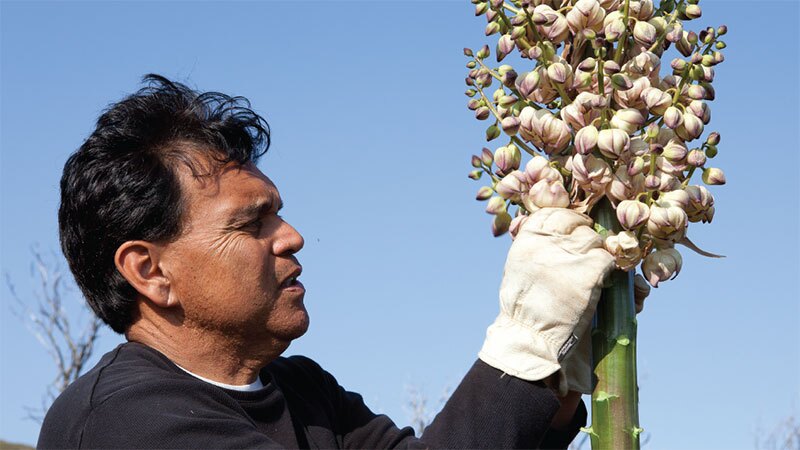Indigenous Cooking: Yucca Petal Hash


Watch our documentary Tending The Wild on KCET TV, February 7 at 9:00 p.m.
We are the Chia Cafe Collective, a grassroots group of southern California tribal members and collaborators committed to the revitalization of Native foods, medicines, culture, and community. Our work honors the vast traditional knowledge and spiritual relationship to the land, and the nutritive and medicinal bounty the land offers us. Through workshops, classes, demonstrations, and native foods celebrations, we focus on ways to re-incorporate Native food plants into our daily diets to take back responsibility for our health and well-being. We hope our recipes can help you reconnect with the land through gathering, gardening, and cooking Native foods.
We promote an ethic of gathering and cultivating native plants in a manner that is sustainable, and we stress the importance of preserving native plants, plant communities, habitats, and the land for the future generations of all species.
From a Native perspective, part of the traditional knowledge about the yucca is knowing what, where, and when to gather, and how to prepare the different parts of the plant not only for immediate consumption but for later use as well.
The yucca plant and its various parts are a staple for many southern California Native people. Everyone thinks in terms of blossoms, but the young stalk is also edible. If you miss the opportunity to harvest the stalk, you can go back and collect the blossoms. If you miss the blossom season, you can go back and get the fruit pods. If you miss the young, green fruit pods, you can return several weeks later to gather the dried pods, break them open, collect the seeds, and grind them down into a flour.
In many states, yucca is a protected plant and can only be harvested with a permit, which is why it is not available commercially. We gather blossoms on our friends’ lands for workshops and gatherings. Fresh blossoms are edible in very small quantities and can be sprinkled on salads, but be careful not to eat too many, as they may irritate your throat.

INGREDIENTS
1 onion, sliced
3 garlic cloves, minced
3 T olive oil
1/2 green or red bell pepper, sliced
1 T olive oil
2 C yucca petals, cooked
1 tsp sugar (or sweetener of your choice)
1 tomato, chopped
1/2 C cholla buds, boiled (optional)
salt and pepper to taste
Pre-Prep
If the fresh blossoms have grown large and full, twist out the center of the blossom before using, as those become increasingly bitter with age. If gathering blossoms when they first start to open, there is no need to remove the center portion.
Blanching
Fresh yucca blossoms are boiled in 2 or 3 changes of water (15-20 minutes each time) to remove a bitter yellow liquid. When the water is a pale yellow, drain blossoms and hand-squeeze to eliminate any excess moisture. The blossoms are now ready to be used in recipes. Fresh blossoms should be used within a few days. If you air-dry or dehydrate the blossoms for later use, you still need to blanch them to remove the bitterness before reconstituting them for use in a recipe.

PREPARATION
Sauté the onion, garlic, and green or red pepper in oil for 3 minutes.
Add the yucca petals. Continue to sauté 10-15 more minutes until the yucca petals are tender but still hold a light crispness.
Add sugar and stir in the chopped tomato and cholla buds. Heat thoroughly.
Add salt and pepper.
Serve on tortillas or as a side dish.
This recipe is reprinted with permission from Cooking, Culture, Community: Cooking the Native Way by the Chia Cafe Collective. Banner image by Chris Clarke

Co-produced by KCETLink and the Autry Museum of the American West, the Tending the Wild series is presented in association with the Autry's groundbreaking California Continued exhibition.


